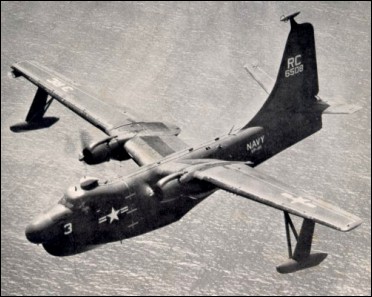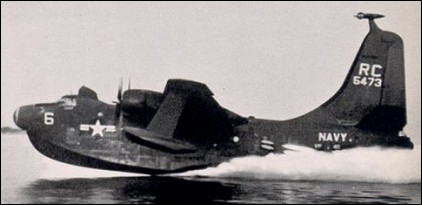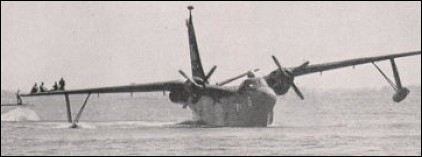|
| With the US Navy requiring a new patrol flying-boat, Martin decided to develop the successful PBM Mariner, the resulting Martin Model 237 design combining the wing and upper hull of the Mariner with the new lower hull structure. The close relationship between the two types is emphasised by the fact that a PBM-5 Mariner served as the prototype XP5M-1 which, when ordered into production, was given the name Marlin. The modified hull of the XP5M-1 incorporated radar-directed nose and tail turrets, as well as a power-operated dorsal turret, and power was provided by two 2424kW Wright R-3350 radial engines. This prototype flew for the first time on 30 May 1948, but it was not until two years later that the P5M-1 was ordered into production, the first of these series aircraft being flown on 22 June 1951. Initial deliveries, to US Navy Squadron VP-44, began on 23 April 1952 and the type remained in service until the mid-1960s. In addition to those operated by the US Navy, 10 of the later P5M-2 version were supplied to France under the American MAP for use by the Aeronavale.
| MODEL | P5M |
| CREW | 11 |
| ENGINE | 2 x Wright R-3350-32WA Turbo-Compound, 2573kW |
| WEIGHTS |
| Take-off weight | 38555 kg | 85000 lb |
| Empty weight | 22900 kg | 50486 lb |
| DIMENSIONS |
| Wingspan | 36.02 m | 118 ft 2 in |
| Length | 30.66 m | 101 ft 7 in |
| Wing area | 130.62 m2 | 1405.98 sq ft |
| PERFORMANCE |
| Max. speed | 404 km/h | 251 mph |
| Ceiling | 7300 m | 23950 ft |
| Range | 3300 km | 2051 miles |
| ARMAMENT | 3600kg of weapons |
| Carl Stuart, e-mail, 10.07.2015 16:45 I was an AO3 stationed in Norfolk Va. Squadron VP44 from 1958 to 1961 In 1961 we received P3V which was a Plane that had to land on a runway instead of landing in the water I always enjoyed both planes but I like the P5M better because of the room and the view when looking out for other aircraft it wa a great experience reply | | Bill Clarke, e-mail, 01.07.2015 19:06 Hey Dombrowski were you bald at 19? reply | | Al Fowler, e-mail, 15.05.2015 01:12 How can I contact a commenter? reply | | Glen Pierce, e-mail, 07.05.2015 04:31 I have photos of my father's 1943, i believe, Pbm mariner RP-55 (navy). He was based at Banana River Florida. I can send the photo for you to decide what RP means. glen reply | |
| | Bruce Barth, e-mail, 04.05.2015 03:05 Cheryl Wilson - I would love to help you with the book you are doing for your father. Please contact me - my contact information is on my website at www vpmma org reply | | Dan Eaton, e-mail, 25.04.2015 05:12 I was an AT with VP46 from 1957-1960. We rotated with three other squadrons every 6 months between North Island and Sangley Point in the Philippines (near Cavite). Besides working in the shop, I was the radio and MAD operator on boat 7. Mostly we flew patrols over the south china sea checking on shipping. When mainland China started shelling the offshore islands of Quemoy and Matsu, there was concern it could be the start of an invasion. At that time, we flew patrols over the Taiwan straights working off a seaplane tender at BoCoCo. In answer to one of your questions, the landing gear (can't remember what they were actually called) were only attached when a plane came back in so it could be towed back up a ramp to park. Then of course, they were removed just before taking off. The P5M was a true seaplane, not an amphibian. If you send me your e-mail, I can send you some pictures relating to this and other operations. reply |
| Cheryl Wilson, e-mail, 21.04.2015 02:25 @Bruce Barth or ANYONE! I am writing a book about my father's experience in the Navy. He is 85 years old. I am in great need of some minor technical information on the takeoff and landing of the P5M and your comment caught my attention. Would you be able to help me? I only have a page or two on the plane but I want to be accurate in my descriptions and there is very little that I can find on the internet. There is some information on landing procedures (attaching gears, etc.) but nothing on takeoff. My dad worked on them, put the gear on them and would use a speedboat to assist. He has spoke of a line and a quick release? Stirring up waves to help the plane break the surface? Can anyone help? Thank you. reply |
| Rick Dombrowski, e-mail, 26.03.2015 10:14 I was assigned as the PC on QE-7 at Sangley Point, R.P. Worked in the Mech Shop when not flying. Had some interesting events on several patrols and worked with a great crew to get the job done. LT Bob Westlake was PPC, Ltjg Stebbins and Ltjg Stroup were 2P and 3P; Dominese was Radar, Hiser was Radio, Masterson was Structures /Hydraulics, Saterfield was Electric and Wilson was the other AT. This crew flew the P5M-1, BuNo 126501, which we had the priviledge to fly back to San Diego, turn in the A /C, go thru updated equipment training and fly a new P5M-2 back to Sangley Point. I personally accomplished this twice with flying another P5M-1 to San Diego to do the same swap and fly another new P5M-2 back to Sangley Point. The last transpac was under the expert guidance of LT Keith Wilkinson . Seaplane flying was unique and a demanding aspect of patrol duties. Our Crew 4 was personally involved with the rescue of a NorthWest Orient DC-6B that was forced to ditch between Guam and the Philippines; a tribute to that aircrew's talent in getting the plane down in an open sea landing and recovering the lion's share of the survivors from the downed aircraft. It was a distinct pleasure to serve with men such as these of VP-40. reply | | richard chamberlain, e-mail, 17.03.2015 03:16 chamberlain I was on the P5M that had to land at sea because the starboard engine caught fire.We used both extingishers,it was still burning.we were given a cardboard write up by Martin. I am ret.AO 1.Spelling(extinguishers) reply | | Robert (Bob) Hummel, e-mail, 14.03.2015 11:58 I was with VP45 in Coco Solo, Panama in '54 when we received our first P5M-1, Number 12. I was the electronics tech and third radioman on that crew, until I left the Squadron in May for VR1 in Pax River. Enjoyed my time as a crew member. reply | | Harold Marchant, e-mail, 12.03.2015 02:29 How would I contact a person who wrote a comment about the Martin P5M. We shared an apartment at North Island. He says, drop me a line. Where would I find his address?
Harold Marchant reply | | Frank Notarnicola, e-mail, 25.02.2015 20:01 I flew as a P5M-1 2nd Mech 1958-59 in
ATU501 /VT29 Corpus Christi, TX. Loved the P Boats. Next assignment was USS Pine Island AV12 San Diego / WestPAC. While on Pine Island 1961 /62 picked up crew of VP40 Sangley Pt that went down in Philppine Sea. Had engine fire landed on water to extinguish Fire. Picked up crew and lifted plane on deck at night on the high seas. First time ever night time pick up at sea. Anyone out there part of rescued aircrew or Piney Maru remember this event? reply |
| Gerald Lillie, e-mail, 23.01.2015 17:34 Flew in the P5M's as radioman and electrical panel operator. ATU 501 in Corpus Christi,TX, 1957. VP-31 in North Island,CA, 1962 to 1965. Retired as ATC in 1973. reply |
| Ronald D.Peters, e-mail, 19.01.2015 07:56 I was in VP 31 from the fall of 1962 until summer of 1963. I worked in the tool crib in the seaplane hanger. My boss took me along on a training flight on a PB5M I remember they used a boat to detach and attach the wheels. It was quite exciting for a farm boy from SD just turned 18. reply | |
| | bill klawon' ao1,ret, e-mail, 10.01.2015 00:51 Ordnanceman vp48,vp50 (sg-3),vp31. '59-'65.good times in
Iwakuni with those crazy crew 3 AT's. reply | | Ron Jerger, e-mail, 03.01.2015 18:03 Flew for over two years as a crew member in VP-48. I was an AO3. My Job besides an ordence man was to cook and grab the rope eye upon approaching the ramp. I love it and seems like only yesterday some times. reply | | William U Yates, e-mail, 22.12.2014 02:57 W U Yates contact at wuyates@cox.net reply | | William U Yates, e-mail, 21.12.2014 02:34 I am fascinated by the first couple entries; I was a AEMAN when I reported to VP-47 in January 1959 at Alameda. Went to Iwakuni and worked in EBU, I am called an AD in the cruise book. I will scan and email pictures if anyone wants a page. reply | | George j spencer, e-mail, 03.11.2014 17:09 I was enlisted from 1958 thru 1962' served in the vp 47 seaplane squadron, went to Iwakuni, Japan. After airframes school in 1958, in Memphis Tennessee.
Am interested in contacting any airmen who served in my squadron with me. I served under a great leader ; commander Gorman, CO.
I worked on the hydraulics, and airframes on the p5m seaplanes.
Anyone remember ?. please contact me at my e-mail address, gpspencer@centurylink.net. god bless you each and everyone who served in defense of our great USA. Spence !!!
Commander Gorman
U reply | | Ralph Doudna, e-mail, 21.08.2014 09:36 My first duty assignment upon graduating from ATAN school was VP-47 Alameda from Mid 1959 to mid 1962. Checked into the squadron as an ATAA and left for ATIB school as an AT2. Made my first flight as a tail observer shortly after checking in to the squadron. The command pilot was CDR Gorman XO. I can still recall that flight. The squadron deployed to Iwakuni, Japan 1959-1960 and was relieved by VP-50 one month late due to an unfortunate and costly training accident they had experienced while at Whidbey Is. We returned to Alameda and the squadron was reassigned to Whidbey Is. I eventually was assigned to flight crew and flew with crew 4. About the only flight gear enlisted received in those days was a flight jacket helmet and gloves. PPC was LCDR Wilson, Pilots were Lt's Dorsey Brown, Dick VanGermit, Skip Rawlins, Monte Killingsworth, Ltjg Link, Enlisted were, Erine Hill, David Payne, Jim Bateman, Maurice Sherman, Ron Keys, Paul Newbury, Jim Davis, Ken Hanway and Carlton Harris, not all these members were in crew four at the same time. My time and numerous hours both on the ground and in the air with crew four will forever be some of my fondest memories. They were a great group to serve with and We all did a lot of growing up under each others guidance. Flying in the old P5M-1 and -2 was a challenge and experience I would not trade for anything and there is no way of relating those times to someone who has not experienced it. We were deployed to Alaska with the USS Curtuck in 1962 and were ridding the buoy in Old Woman Bay, which required 3 enlisted and 1 pilot to control the aircraft incase the aircraft broke away from the buoy, Ltjg Link wondered what a PDC sounded like when it went off so he had Sherman throw one off the port wing and nothing happened, thinking it was a dud we threw another off the stbd wing nothing happened until about 2 in the morning when the tide came in and the water depth exceeded 50 ft, Those things went off a few seconds apart and our curiosity was forever satisfied . I would also like acknowledge Tommy Thompson the Marin Rep who more than once rolled up the sleeves of his white shirt and helped troubleshoot and repair a difficult problem. Retired out of the Navy as an CPO in 1994 and would like to thank all those who contributed to my career along the way. reply |
|
Do you have any comments?
|
| 
COMPANY
PROFILE
All the World's Rotorcraft
|



 Dan Eaton
Dan Eaton Dan Eaton
Dan Eaton Dan Eaton
Dan Eaton Robert Bunderson
Robert Bunderson Michael Stuart
Michael Stuart Michael Stuart
Michael Stuart RL Brant
RL Brant Bob Bunderson
Bob Bunderson Cheryl Wilson
Cheryl Wilson Cheryl Wilson
Cheryl Wilson Al Martinez
Al Martinez Frank Notarnicola
Frank Notarnicola Mark
Mark Gerald Lillie
Gerald Lillie Ralph Doudna
Ralph Doudna





Hi Dan,
I was an AT radioman with VP-46 in 1958 and participated in the 2nd Taiwan Straits Crisis. Our boat crashed on top of a coral reef when attempting takeoff. Do you remember the name of the seaplane tender that was in the area? I am writing my story of that time in my life. Any photos would be appreciated..
Al Martinez
949 939-0470
reply